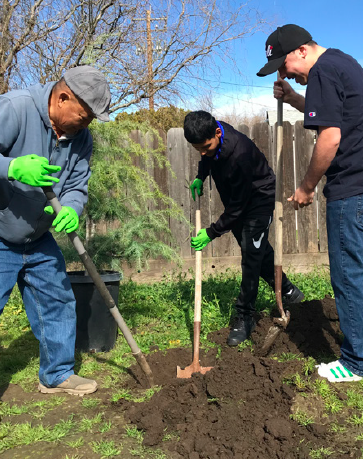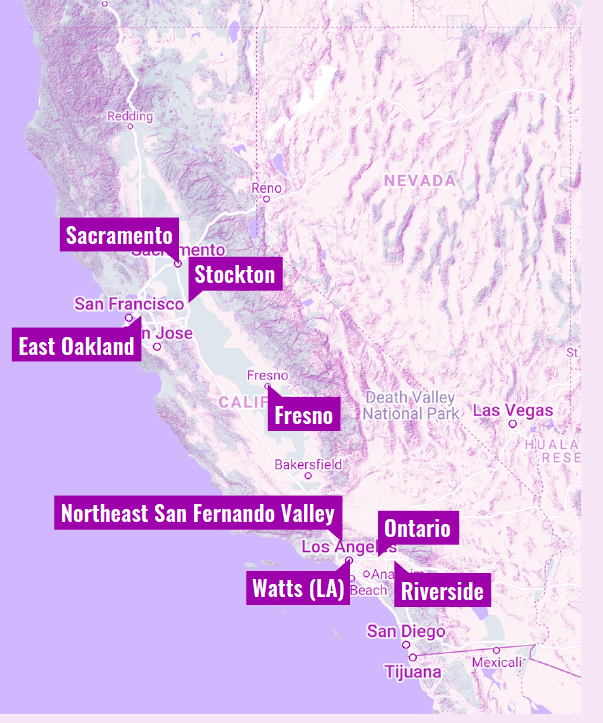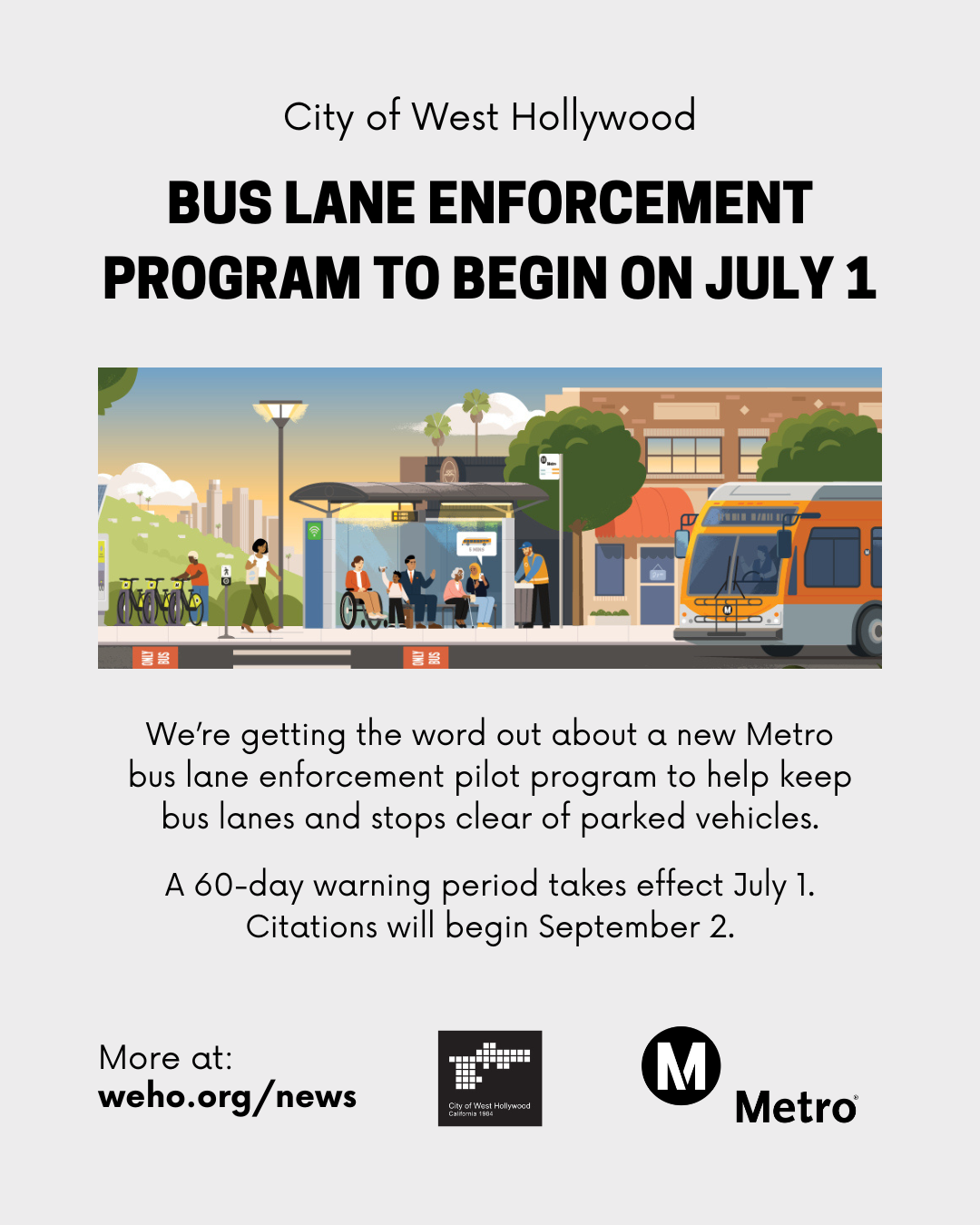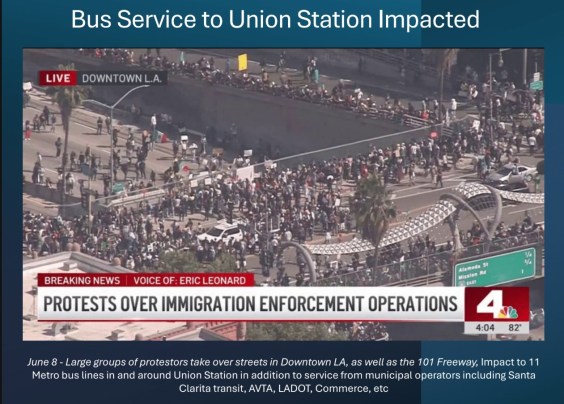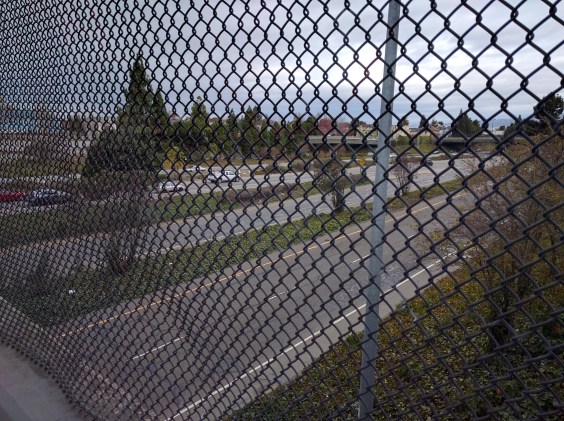Note: GJEL Accident Attorneys regularly sponsors coverage on Streetsblog San Francisco and Streetsblog California. Unless noted in the story, GJEL Accident Attorneys is not consulted for the content or editorial direction of the sponsored content.
Five years after the Transformative Climate Communities (TCC) grant program was created with funding from California's cap-and-trade, The Greenlining Institute has completed a report on its progress.
Its conclusions: The TCC is a success, and could serve as a global model for equitable climate policies - but it's not big enough and not funded anywhere near enough.
Greenlining looked in detail at five communities that had applied for and received grants under the program: Ontario, Northeast San Fernando Valley, Eastern Coachella Valley, East Oakland, and Stockton.
Each of these communities received a grant to either plan or implement "neighborhood-level transformative climate community plans” that reduce greenhouse gas emissions while providing other benefits such as cleaner air, better health, better transportation, and jobs.
TCC was created by A.B. 2722 in 2016 with the understanding that in order to truly tackle climate change, every community needs to be able to foster sustainable ways to live. That is, if California's climate efforts simply follow historical patterns of top-down planning and regulation, they could end up making life (temporarily) better only for more affluent communities. But climate change effects like wildfire, heat, and flooding are felt more drastically where people have historically had less ability to protect themselves: in low-income, marginalized communities of color.
And if people who have been marginalized are left out of efforts to clean up pollution and fight climate change, in the end nobody will be any better off.
Community Collaboration
To that end, the TCC program required communities to work together to decide what they needed - they specifically could not be top-down, government-led efforts, but had to incorporate what residents wanted.
That makes it a unique governmental program. Although community collaboration principles are starting to get attention in other areas of planning, they are fundamental to the TCC program.
Community-led plans could include almost anything, as long as they move the needle towards sustainability. Housing, transit, trees, solar panels, active transportation - whatever residents say they need.
Overall, the report found "substantial success" in creating these plans. "This model should be expanded in California and replicated nationally, by both individual states and the federal government."
Also, "even though implementation has only recently started in many places, TCC is already producing concrete results," according to the report. These include a new bike-share program that’s expanding clean transportation and creating jobs in East Oakland, and a formerly neglected alley turned into a community green space in Pacoima. "Projects in the works include affordable housing near transit, EV charging, solar panels for low-income households and more. Overall, these communities are on track to reducing nearly 200,000 metric tons of CO2 emissions over the next five years, equivalent to removing nearly 43,000 cars from the road."
Strengths of the program include the way it builds equity into every step, rather than tagging it on as an adjunct to its primary goal of reducing GHGs. Another strength is its focus on supporting community planning from the beginning stages of identifying needs and articulating a vision through creating, planning, and funding strategies to get there. That requires coordinating across organizations and sectors, from engaging community groups to bringing in housing, transportation, and health agencies.
For example, Ontario residents named three top priorities: to breathe healthy air and be free from chronic disease, to feel safe and comfortable walking and biking, and to live in an affordable home. The plan they came up with includes new affordable housing, improved transit service, bike lanes, pedestrian improvements, rooftop solar power, tree planting, and a composting program.
Another strength of the TCC program is its insistence on integrated plans that bring broad community benefits, such as workforce development, avoiding displacement, and increasing climate resilience. The TCC process involves community members in developing plans that touch on all of these, keeping people involved and aware, and giving them ownership over results.
But there are challenges. Getting communities involved is not easy, in part because of long-established traditions of top-down planning but also because community members often have reason not to trust the process. For example, in the Eastern Coachella Valley the TCC planning grant was led by local government agencies, in partnership with Leadership Counsel for Justice & Accountability (LCJA).
But, says the report, "While LCJA led community engagement activities, they were not included in all decisions and had to advocate on an ongoing basis to ensure incorporation of community voices in the process and plan. Stakeholders expressed frustration that insufficient local and state resources hindered community outreach and engagement efforts, that the consulting firm responsible for creating the climate resilience plan didn’t directly engage with residents, and that the action plan initially left out several key resident recommendations until intensive revisions ensured" their inclusion.
In Stockton, the TCC grant was an opportunity to build a new model of shared governance between nonprofit partners and the city of Stockton. "Given that partners did not have a deep history of working together, partners anticipated that situations of tension or conflict might occur over the course of multiple years of implementation," write the authors. "Partners hoped to include anti-racism trainings and conflict mediation... in order to better align partners on a shared set of values and give teeth to collaborative governance in times of disagreement. However, given the many other needs of grant funding, there were not enough resources to allocate to conflict mediation and anti-racism trainings that would have helped operationalize and support collaborative governance."
The report recommends that the Strategic Growth Council, which oversees the grant program, offer models and best practices for communities to overcome some of these obstacles. The SGC has engaged state agencies on racial equity capacity-building programs, and should do the same for local governments.
"TCC communities entered into collaborative relationships with different pre-existing levels of shared work, trust and understandings of racial equity," writes the report. "Many of our stakeholder interviewees reported wanting to conduct equity trainings, especially for their local government partners, but not having the extra funding to do so... SGC should support local and regional government partners to embed racial equity within their own institutional cultures, policies and practices. Racial equity trainings would be a starting place to support TCC stakeholders in developing a shared vision of confronting racism and injustice."
The SGC should also, says the report, track and evaluate "procedural equity" to learn whether the TCC is achieving the wider societal benefits it is setting out to achieve.
Consistent, Reliable Funding - and More of It
Not surprisingly, however, the main recommendations for state government is to provide consistent, reliable funding, and more of it. The report recommends that the TCC be continued and expanded, that state leaders ensure that its funding is "adequate and consistent," and that needless funding barriers are removed. It also recommends finding more ways to build community capacity, including technical assistance, peer-to-peer learning, and clear guidance, including best practices and models to learn from.
"Capacity remains a major problem. Legacies of disinvestment, coupled with TCC’s ambitious scope, all but guarantee that communities will struggle with capacity challenges... Our most under-resourced communities are the least likely to have the staffing or technical expertise to manage [the TCC] requirements, and stakeholders from both the nonprofit and public sectors all reported contributing significant uncompensated time and labor in order to develop and implement robust, community-informed and collaborative projects."
Finally, the report recommends that the TCC be expanded nationally. As a model for addressing climate change, the TCC offers a way to "simultaneously fight climate change and build community health and prosperity... We must fund the pathway from planning to implementation, and support the local ecosystems needed to support community transformation."
The above is a very quick look at a few of the many recommendations put forward in the report; for more information and detailed analysis, find the full report here.
TCC was envisioned both as a way to transform communities in an equitable and sustainable way as well as a way to learn how to do so in a way that could be replicated. The message may be that governments at all levels need to invest more in communities themselves, period. That is, let residents decide what they need and want, rather than putting money into projects that, for example, support local industry in the name of "jobs," but sometimes to the detriment of the local community.
It's not the way that government works now, not in planning and not in the legislature, except for within small experimental programs like the TCC. But it could be a model for a better way to live, and govern.
